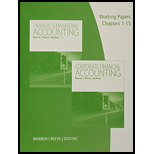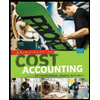
Concept explainers
(1)
Activity-based costing (ABC) method: The costing method which allocates
Formula to compute activity-based overhead rate:
To compute: The activity-based overhead rate for each of the given activities
(2)
To compute: The activity-cost allocated to total and per unit of each of the products.
(3)
To discuss: The reason for the difference in activity-based overhead cost per unit of each of the products, despite the equal consumption of 40 minutes of machine time per unit.
Want to see the full answer?
Check out a sample textbook solution
Chapter 26 Solutions
Working Papers, Volume 1, Chapters 1-15 for Warren/Reeve/Duchac's Corporate Financial Accounting, 13th + Financial & Managerial Accounting, 13th
- Please help me solve this general accounting question using the right accounting principles.arrow_forwardCan you solve this general accounting problem with appropriate steps and explanations?arrow_forwardI am trying to find the accurate solution to this general accounting problem with the correct explanation.arrow_forward
- ← Week 1: Homework Question 3 of 4 8.75/10 The project is completed in 2025, and a successful patent is obtained. The R&D costs to complete the project are $113,000. The administrative and legal expenses incurred in obtaining patent number 472-1001-84 in 2025 total $16,000. The patent has an expected useful life of 5 years. Record the costs for 2025 in journal entry form. Also, record patent amortization (full year) in 2025. (Credit account titles are automatically indented when amount is entered. Do not indent manually. If no entry is required, select "No Entry" for the account titles and enter O for the amounts. List all debit entries before credit entries.) Account Titles and Explanation Research and Development Expense Cash (To record research and development costs) Patents Cash (To record legal and administrative costs) Amortization Expense Patents (To record one year's amortization expense) Debit 113000 16000 3200 Credit 113000 16000 3200arrow_forwardJoe transfers land to JH Corporation for 90% of the stock in JH Corporation worth $20,000 plus a note payable to Joe in the amount of $40,000 and the assumption by JH Corporation of a mortgage on the land in the amount of $100,000. The land, which has a basis to Joe of $70,000, is worth $160,000. a. Joe will have a recognized gain on the transfer of $90,000. b. Joe will have a recognized gain on the transfer of $30,000.c. JH Corporation will have a basis in the land transferred by Joe of $70,000. d. JH Corporation will have a basis in the land transferred by Joe of $160,000. e. None of the above.arrow_forwardPlease provide the correct answer to this general accounting problem using accurate calculations.arrow_forward
 Managerial AccountingAccountingISBN:9781337912020Author:Carl Warren, Ph.d. Cma William B. TaylerPublisher:South-Western College Pub
Managerial AccountingAccountingISBN:9781337912020Author:Carl Warren, Ph.d. Cma William B. TaylerPublisher:South-Western College Pub Cornerstones of Cost Management (Cornerstones Ser...AccountingISBN:9781305970663Author:Don R. Hansen, Maryanne M. MowenPublisher:Cengage Learning
Cornerstones of Cost Management (Cornerstones Ser...AccountingISBN:9781305970663Author:Don R. Hansen, Maryanne M. MowenPublisher:Cengage Learning Principles of Cost AccountingAccountingISBN:9781305087408Author:Edward J. Vanderbeck, Maria R. MitchellPublisher:Cengage Learning
Principles of Cost AccountingAccountingISBN:9781305087408Author:Edward J. Vanderbeck, Maria R. MitchellPublisher:Cengage Learning Financial And Managerial AccountingAccountingISBN:9781337902663Author:WARREN, Carl S.Publisher:Cengage Learning,
Financial And Managerial AccountingAccountingISBN:9781337902663Author:WARREN, Carl S.Publisher:Cengage Learning, Managerial Accounting: The Cornerstone of Busines...AccountingISBN:9781337115773Author:Maryanne M. Mowen, Don R. Hansen, Dan L. HeitgerPublisher:Cengage LearningPrinciples of Accounting Volume 2AccountingISBN:9781947172609Author:OpenStaxPublisher:OpenStax College
Managerial Accounting: The Cornerstone of Busines...AccountingISBN:9781337115773Author:Maryanne M. Mowen, Don R. Hansen, Dan L. HeitgerPublisher:Cengage LearningPrinciples of Accounting Volume 2AccountingISBN:9781947172609Author:OpenStaxPublisher:OpenStax College





